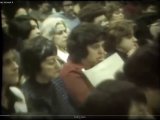You are here:
School Governance and Democratic Control
Who decided what happened at Mark Twain Junior High School? Many of the decisions that produced segregation at the school, including school zone lines, were made by Community School District 21. It’s important to ask not only what decisions fostered segregation, but who was making them.
Community School District 21 was one of 32 local districts created in New York City starting in 1970. Each local district had a school board elected by the voters and parents in the district.
Read More
The boards were created in part to respond to years of parent and community protest, especially by Black and Latinx parents, for more power over local schools. The new community districts’ boards made decisions about matters like school zoning and hiring principals. But this “decentralized” structure was a compromise, not the more thorough “community control” of local schools that Black and Latinx activists had wanted.
Community school district boards often did not reflect the population living and going to school in their local district. Community School District 21 was majority white, with a sizeable minority of Black and Puerto Rican residents. In the early 1970s, when Community School district 21 was making decisions that segregated Mark Twain, and for at least fifteen more years, there were no Black or Puerto Rican representatives on the district’s local school board.1 During negotiations about how to desegregate Mark Twain, Black and Latinx community members in Community School District 21 did not have representatives from their communities on the board.
Judge Jack Weinstein ordered Community School District 21 to make a plan to enroll around 70% white students and 30% Black and Latinx students at Mark Twain.2 The District 21 board decided to achieve this goal by moving all of the district’s “gifted and talented” classes to the school. Board members said this was necessary to make white families want to send their children to Mark Twain, rather than requiring them to do so. However, the largely Black and Latinx students who had attended Mark Twain previously would now be required to travel out of their local neighborhood to attend other schools if they did not qualify for the “gifted and talented” program.
This plan drew criticism from many Black community members, including Kenneth Clark. Critics pointed out that the Hart desegregation case focused initially on the lack of educational opportunity for Black students like Jeffrey Hart at Mark Twain. But the case had turned into an effort to provide a “special type” of school for “special” students (most of whom were presumed to be white) through the “gifted and talented” program.3
Other Black activists at the time were focused less on desegregation - which percentage of which group of students went to the school - and more on control and authority over what happened in schools. Activists like Stokely Carmichael, who coined the term “Black Power,” asked how much power Black parents and families had over their children’s educations. Likely he would have asked how much power Black parents had to decide what was happening at Mark Twain Junior High, or in Community School District 21.
In 1966, Carmichael wrote that “The people in the Negro community do not control the resources of that community, its political decisions, its law enforcement, its housing standards; and even the physical ownership of the land, houses and stores lie outside that community.”4 He might have made a similar point about how decisions were made about Mark Twain. To Carmichael, desegregation without power or control was not a victory.
-
Alexandra Freidus and Pedro Noguera, “From ‘Good Will’ to ‘Anachronism’: Racial Discourse, Shifting Demographics, and the Role of School Desegregation in the Public Good,” Humanity and Society 39, no. 4 (2015): 394-418. ↩︎
-
Hart v. Community School Bd. 21, 383 F. Supp. 699 (1974). ↩︎
-
“Clark Hits Integration Plain at Mark Twain JHS,” New York Amsterdam News, July 27, 1974. ↩︎
-
Stokely Carmichael, “Toward Black Liberation,” (excerpt) Massachusetts Review (Autumn 1966), in National Humanities Center Resource Toolbox 3, https://nationalhumanitiescenter.org/pds/maai3/segregation/text8/carmichael.pdf. ↩︎


